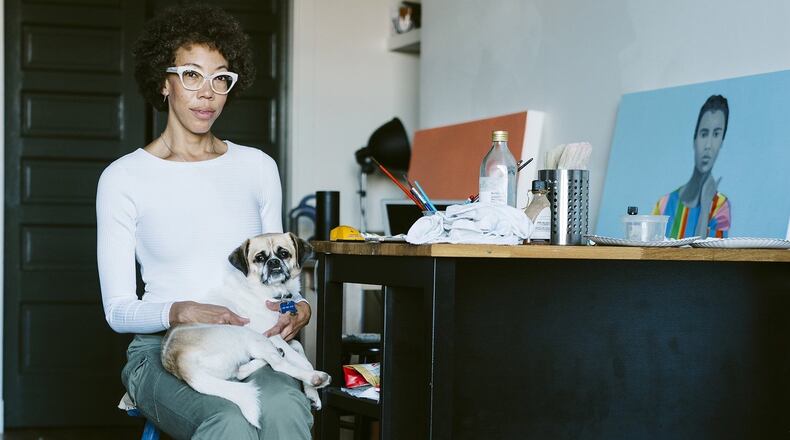Before painter Amy Sherald was grabbing headlines for her National Portrait Gallery rendition of former First Lady Michelle Obama last February, she was a Clark Atlanta University fine art student, who hung out at Ponce de Leon's Eats and Club 112, living in an apartment in Reynoldstown.
On Jan. 31, the 45-year-old Columbus native returns to her former stomping grounds for a solo exhibition of nine of her exquisite, game-changing paintings at the Spelman College Museum of Fine Art and lectures at Spelman and the High Museum of Art.
“I have really fond memories of college and coming into myself,” Sherald, who now lives in Baltimore, told “Art Papers” in August 2018. “Atlanta’s still one of my favorite cities — it’s a little bit overpopulated for me now, because all the side streets that used to be shortcuts to avoid traffic are full of traffic and characters now!”
Sherald’s unique approach to portraiture employs a stylized, singular use of color and form that upends the usual portraiture conventions and manages to conflate her subjects’ interior, emotional states with their outward appearance. Using models found in unexpected places like the gym or the grocery store, Sherald calls herself an “American realist” who invests the ordinary black Americans she paints with a mysterious, magnetic quality.
“Sherald paints (her subjects) as dignified and complex beings set against a backdrop of saturated color,” says Valerie Cassel Oliver, Virginia Museum of Fine Arts curator of modern and contemporary art. Oliver served on the panel that selected Sherald for the 2018 David C. Driskell Prize from the High Museum of Art, awarded to artists and curators who have contributed to the field of African-American art. She says Sherald’s portraits of an often underrepresented group of people is groundbreaking.
“There is a human need to see oneself, one’s community, thoughts and/or beliefs reflected,” she says. In that regard, Sherald has done much to change our vision of what it means to be black. And in doing so, she has imprinted the course of art history, challenging audiences to consider who we think is worthy of a portrait. As Michelle Obama herself noted, when her official portrait was unveiled, until Sherald painted her, no one in her own family had ever sat for a portrait.
That portrait catapulted Sherald into the national spotlight, but her work was already garnering attention. In 2016, she was selected from among 2,500 entries as the winner of the National Portrait Gallery’s Outwin Boochever Portrait Competition. It was the first time that prize was given to a woman in its 10-year history.
New York magazine senior art critic Jerry Saltz, who served on the jury that selected Sherald for the prize, describes how Sherald’s portraits play out W.E.B. Du Bois’ idea of “double consciousness,” in which black people are constantly regarding themselves through the lens of racist prejudice.
“Sherald both removes the figure from its surroundings — isolating a body in a deeper intensity, density and separateness — and drives to the inner-recesses of ‘double-consciousness’ while also recreating this experience in the viewer,” says Saltz.
The realm of portraiture has often been known more for its conventionality and predictability than for challenging historical representation and our ideas about race and gender. In the Eurocentric traditions of art history, portraiture often has been a means of propping up the status quo and valorizing mostly white men of means.
Sherald has taken a different approach. As she told NPR in May 2018, “When I looked around at art that was being made by, say, my contemporaries, and I looked at the American art canon, I realized that there was an absence of images of just black people just being black. Just an image of them being themselves. And I think that’s really important.”
Featured in the Spelman exhibition, the painting “She had an inside and an outside now and suddenly she knew how not to mix them,” shows a young black woman with a disarmingly direct gaze dressed in ropes of pearls, a marigold-colored cloche, floral skirt and bright aqua top that pops against Sherald’s electric coral-colored backdrop. She is fierce, cool, individual — everything popular culture tries to erase in telling us African-Americans are uniform and monolithic.
One of Sherald’s painterly “tells” is her use of bright background colors that remove extraneous details and amplify the charisma of her subjects.
“Set against a stark field, she transforms ordinary subjects into monumental forces of nature,” says Andrea Barnwell Brownlee, director of the Spelman College Museum of Fine Art. “These characteristics, coupled with titles that are poetic dreamscapes in and of themselves, make an indelible impression.”
Many have noted how, rather than representing black as a uniform skin color, Sherald “pushes the envelope when delving into aspects of skin as a dominate characteristic of African-Americans.” says curator Oliver. “Rather than paint a subject’s likeness drawing upon a particular skin tone, the artist uses shades of gray and blue to enable the true internal likeness to emerge.”
Fashion plays a big part in Sherald’s paintings, giving us clues about the people we see.
Lisa Melandri, curator at the Contemporary Art Museum St. Louis where Sherald’s solo show originated, notes an almost Surrealist, abstract quality to the graphic patterns in the dresses, skirts and shirts the artist’s subjects wear, including Michelle Obama, whose vibrant Milly dress in her official portrait evokes both Mondrian and Gee’s Bend quilts in a collision of tradition and subversion.
In another work included in the Spelman show, “She always believed the good about those she loved,” a large woman who has made no effort to diminish her size in a bright, festive dress adorned with yellow fruit hints at the bromide of making lemonade when life gives you lemons. That dress and the painting’s evocative title hint at forces of self, and of will and determination that add to our sense that this woman is worth our time and attention. Sherald arrests her in all of her idiosyncratic charm and poignance for our contemplation.
In their colorful outfits, funky hats, scarves and big gold earrings and their “take me as I am” posture of crossed arms and hands on hips, Sherald presents a diversity — especially of African-American womanhood — that feels liberating and celebratory. Always striking an intriguing balance, Sherald’s portraits are a glorification of the humble poetry of real people and the complex vacillation between their inner struggles and outer fierceness.
ART PREVIEW
'Amy Sherald.' Jan. 31-May 18. 10 a.m.-4 p.m. Tuesday-Friday; noon-4 p.m. Saturday. $3 suggested donation. Spelman College Museum of Fine Art, 440 Westview Drive SW, Atlanta. 404-270-5607, www.museum.spelman.edu.
High Museum Lecture. 7 p.m. Feb. 6. $14.50. (Sold out) High Museum of Art, Rich Theatre, 1280 Peachtree St., Atlanta. www.high.org.
Art Papers Live Lecture. 7 p.m. Feb. 7. Free. (Sold out) Spelman College Museum of Fine Art, Cosby Auditorium, 350 Spelman Lane, SW. www.museum.spelman.edu
About the Author
The Latest
Featured





